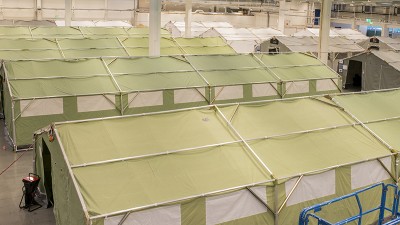Norway’s immigration agency UDI (Utlendingsdirektoratet) has been closing empty asylum centers and reducing staff lately, after last year’s tidal wave of asylum seekers arriving in the country ebbed into this year’s trickle. Some politicians, however, are calling on the government to take in far more Syrian refugees now languishing in camps abroad, while Prime Minister Erna Solberg urged the US and other countries outside Europe to do the same.

Solberg, who’s been attending the opening of the United Nations in New York this week, was urging other countries to better share international responsibility for helping refugees in need of homes. There’s no real decline in the numbers of desperate people fleeing the ongoing civil war in Syria or politial turbulence and violence elsewhere.
The huge numbers of refugees streaming into Europe and Scandinavia last year, however, ended largely because of border crackdowns and an agreement with Turkey to receive them. Now Norwegian authorities see little if any need to keep open all the emergency accommodation facilities set up to handle the 31,000 refugees who arrived in Norway alone last summer and fall.
Late last month, Norway’s UDI announced it was shutting down facilities that could house 7,000 asylum seekers around the country. “Far fewer refugees are arriving now than were expected,” Christine Wilberg, a director a UDI, told news bureau NTB, “and many of those who arrived last year have now either been settled in local communities or sent back.” Immigration Minister Sylvi Listhaug said this week that she wants to maintain the numbers of those sent back because they lack legitimate grounds for asylum. UDI boss Frode Forfang predicted that as many as 15,000 of the refugees currently in Norway face rejection of their asylum applications.
‘Natural to adjust’ staffing and accommodation
Just over 2,100 asylum seekers have arrived in Norway this year, a fraction of the number that came last year. UDI had 235 asylum centers operating nationwide at the end of August, plus 14 transit centers and two arrival centers set up to help handle last year’s influx. Around 21,000 beds were still in use.
UDI announced plans last week, though, to also reduce staffing at the large arrival center set up at Råde south of Oslo last autumn. The immigration agency maintained preparedness for a new wave of refugees through the summer, but with so few arrivals “it’s natural to adjust our staffing there,” said UDI’s Christian Wisløff. The ranks of UDI workers handling asylum applications at its Oslo headquarters are also being thinned, reported newspaper Dagens Næringsliv (DN) last month.
Opportunity to take in others
Politicians like Knut Arild Hareide, a Member of Parliament and leader of the Christian Democrats party, have seized upon the dramatic reduction in refugee arrivals to call for acceptance of other refugees registered by the UN who are currently housed in sprawling refugee camps found, for example, in Jordan. It’s now sheltering an estimate 4 million displaced Syrians, and Hareide thinks at least some of them should be brought to Norway.
“The crises in the world are more demanding than ever before,” Hareide said during last month’s political gathering in Arendal. “Norway was prepared to take in 25,000 more refugees this year.” Since only around 10 percent of that has actually arrived, Hareide claims Norway now has capacity to take in more so-called “quota refugees,” who’ve been certified by the UN as meeting demands for asylum.
Can be profitable
Instead of shutting down the UDI facilities already set up to accommodate refugees, Hareide and Audun Lysbakken, another MP and leader of the Socialist Left party (SV), want to use them to help others. KS, the national organization representing local governments, also thinks it’s wisest to accept more quota refugees, to avoid “setting up facilities, shutting them down and setting them up again later” when the need arises. It would also help prevent the layoffs off UDI workers at a time of rising unemployment in Norway, and maintain a potentially lucrative source of income for local communities, especially those in outlying areas. Many hotel operators, propery owners and others in the accommodation industry have profited on the refugee influx.
Hareide’s Christian Democrats, one of the minority coalition government’s support parties in Parliament, is thus demanding money in next year’s state budget to take in more refugees. The government, however, is keen to retain generally restrictive immigration policies and avoid sending signals that Norway welcomes refugees. Hareide argues that taking in UN quota refugees won’t send any such signals: “These would be people who already have a proven need for protection.”
newsinenglish.no/Nina Berglund

